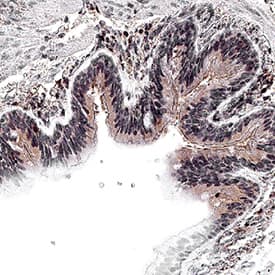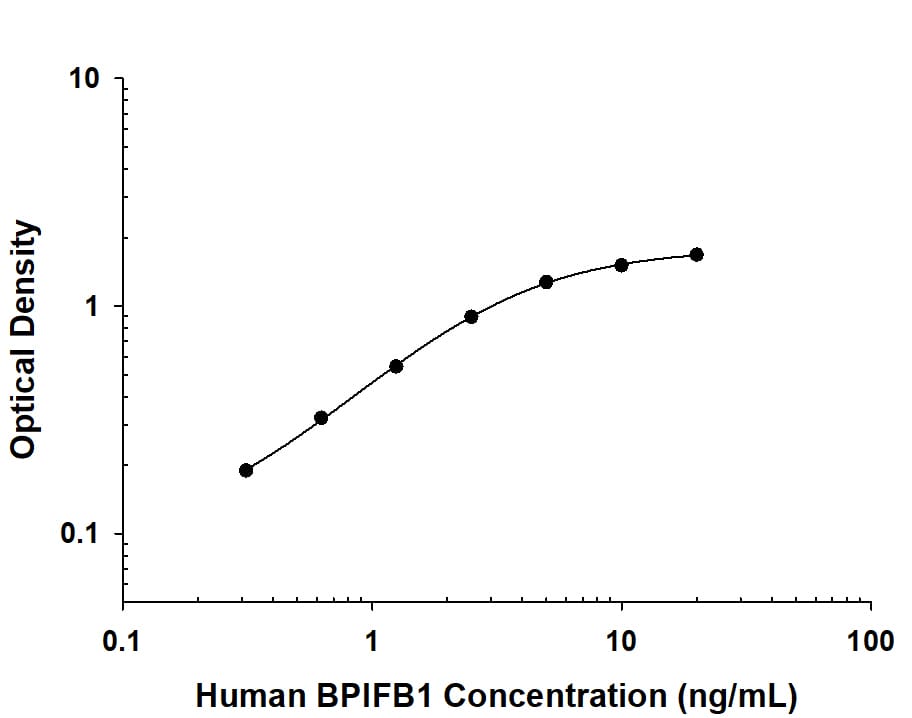Human BPIFB1 Antibody
R&D Systems, part of Bio-Techne | Catalog # MAB101952

Key Product Details
Species Reactivity
Human
Applications
ELISA, Immunohistochemistry
Label
Unconjugated
Antibody Source
Monoclonal Mouse IgG2B Clone # 1023923
Product Specifications
Immunogen
Human embryonic kidney cell HEK293-derived human BPIFB1
Thr22-Gln484
Accession # Q8TDL5
Thr22-Gln484
Accession # Q8TDL5
Specificity
Detects human BPIFB1 in sandwich ELISAs.
Clonality
Monoclonal
Host
Mouse
Isotype
IgG2B
Scientific Data Images for Human BPIFB1 Antibody
Human BPIFB1 ELISA Standard Curve.
Recombinant Human BPIFB1 protein was serially diluted 2-fold and captured by Mouse Anti-Human BPIFB1 Monoclonal Antibody (Catalog # MAB101952) coated on a Clear Polystyrene Microplate (DY990). Mouse Anti-Human BPIFB1 Monoclonal Antibody (MAB101951) was biotinylated and incubated with the protein captured on the plate. Detection of the standard curve was achieved by incubating Streptavidin-HRP (DY998) followed by Substrate Solution (DY999) and stopping the enzymatic reaction with Stop Solution (DY994).BPIFB1 in Human Lung.
BPIFB1 was detected in immersion fixed paraffin-embedded sections of human lung cancer using Mouse Anti-Human BPIFB1 Monoclonal Antibody (Catalog # MAB101952) at 15 µg/mL for 1 hour at room temperature followed by incubation with the Anti-Mouse IgG VisUCyte™ HRP Polymer Antibody (VC001). Before incubation with the primary antibody, tissue was subjected to heat-induced epitope retrieval using Antigen Retrieval Reagent-Basic (CTS013). Tissue was stained using DAB (brown) and counterstained with hematoxylin (blue). Specific staining was localized to epithelial cells in bronchioles. Staining was performed using our protocol for IHC Staining with VisUCyte HRP Polymer Detection Reagents.Applications for Human BPIFB1 Antibody
Application
Recommended Usage
ELISA
This antibody functions as an ELISA capture antibody when paired with Mouse Anti-Human BPIFB1 Monoclonal Antibody (Catalog # MAB101951).
This product is intended for assay development on various assay platforms requiring antibody pairs.
Immunohistochemistry
8-25 µg/mL
Sample: Immersion fixed paraffin-embedded sections of human lung cancer
Sample: Immersion fixed paraffin-embedded sections of human lung cancer
Formulation, Preparation, and Storage
Purification
Protein A or G purified from hybridoma culture supernatant
Reconstitution
Reconstitute at 0.5 mg/mL in sterile PBS. For liquid material, refer to CoA for concentration.
Formulation
Lyophilized from a 0.2 μm filtered solution in PBS with Trehalose. *Small pack size (SP) is supplied either lyophilized or as a 0.2 µm filtered solution in PBS.
Shipping
Lyophilized product is shipped at ambient temperature. Liquid small pack size (-SP) is shipped with polar packs. Upon receipt, store immediately at the temperature recommended below.
Stability & Storage
Use a manual defrost freezer and avoid repeated freeze-thaw cycles.
- 12 months from date of receipt, -20 to -70 °C as supplied.
- 1 month, 2 to 8 °C under sterile conditions after reconstitution.
- 6 months, -20 to -70 °C under sterile conditions after reconstitution.
Background: BPIFB1
References
- Bingle, C. D. and C. J. Craven (2002) Hum. Mol. Genet. 11:937.
- Alves, D. B. et al. (2017) Braz. Oral Res. 31:e6.
- Bingle, L. et al. (2012) Histochem. Cell Biol. 138:749.
- Balakrishnan, A. et al. (2013) Innate Immun. 19:339.
- De Smet, E. G. et al. (2017) Int. J. Chron. Obstruct. Pulmon. Dis. 13:11.
- Saferali, A. et al. (2015) Am. J. Respir. Cell. Mol. Biol. 53:607.
Long Name
BPI Fold Containing Family B Member 1
Alternate Names
C20orf114, LPLUNC1, VEMSGP
Gene Symbol
BPIFB1
UniProt
Additional BPIFB1 Products
Product Documents for Human BPIFB1 Antibody
Product Specific Notices for Human BPIFB1 Antibody
For research use only
